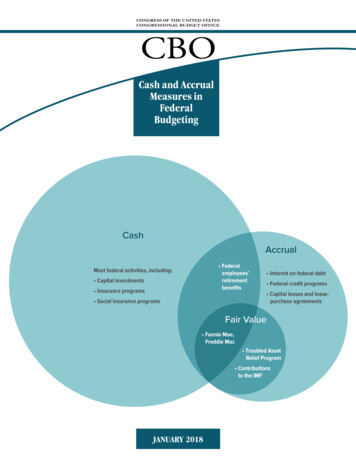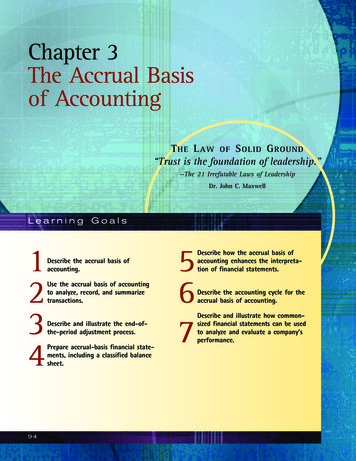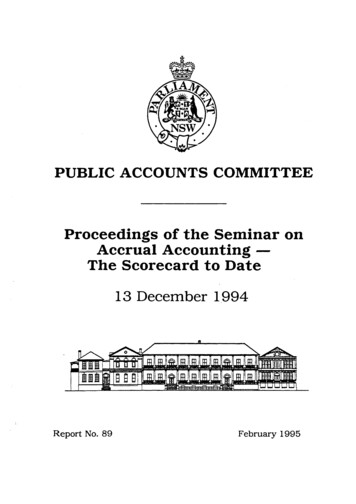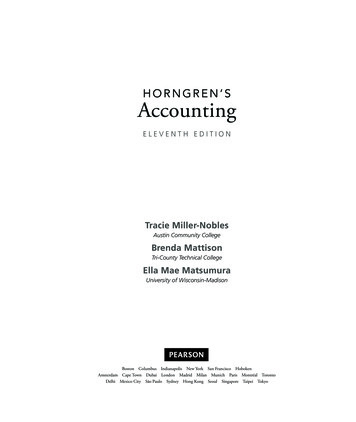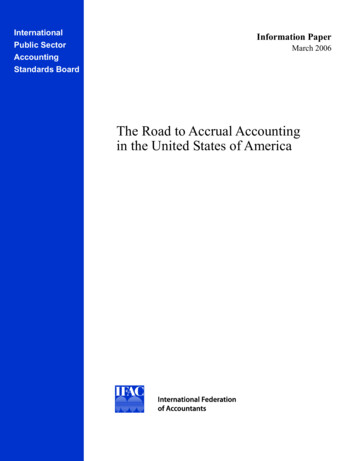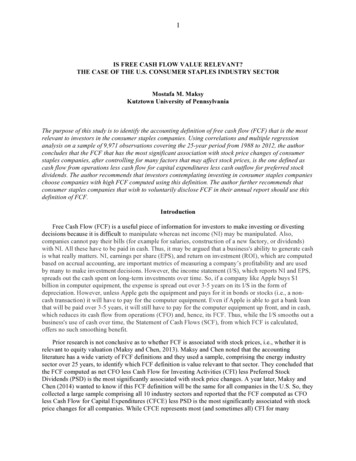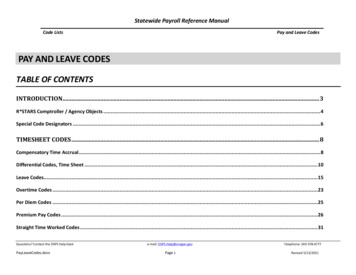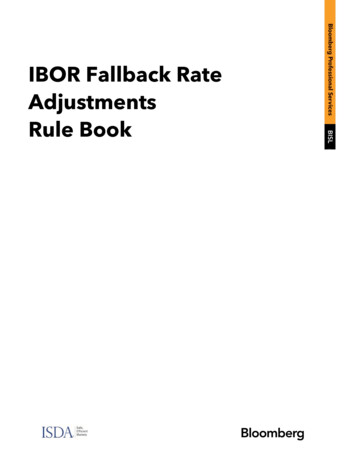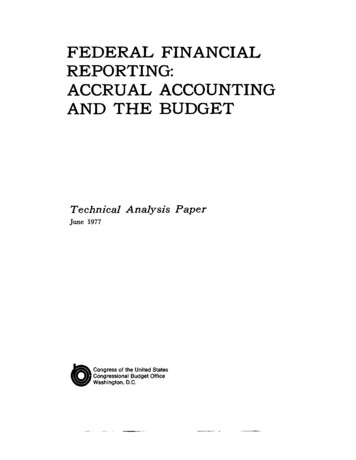
Transcription
FEDERAL FINANCIALREPORTING:ACCRUAL ACCOUNTINGAND THE BUDGETTechnical Analysis PaperJune 1977Congress of the United StatesCongressional Budget OfficeWashington, D.C.
FEDERAL FINANCIAL REPORTING:ANALYSIS OF ACCRUAL ACCOUNTING AND THE BUDGETThe Congress of the United StatesCongressional Budget Office
PREFACEFederal Financial Reporting: Analysis of AccrualAccounting and the Budget is intended to aid thoseconcerned with improving the format of the budget ofthe United States. The paper analyzes proposals forchanges in federal budget practice put forth in areport, Sound Financial Reporting in the FinancialSector, issued in 1975 by the accounting firm ofArthur Andersen and Co., which have received considerable attention in the U.S. Department of the Treasuryand elsewhere.The paper was prepared by Ronald L. Teigen, formerly of CBO's Fiscal Analysis Division and currently onthe economics faculty of the University of Michigan.The manuscript was edited by Patricia H. Johnston andtyped by Joanne Senechal.Alice M. RivlinDirectorJune 1977111
CONTENTSPagePREFACEillCHAPTER I.Background1CHAPTER II.Accrual Accounting and PresentValue Discounting7Accrual Accounting and Discounting8The Economics of Discounting for theFederal Budget11Other Problems16CHAPTER III.CHAPTER IV.Depreciating Federal Government Assets25Possible Consequences of Adoptingthe Andersen Recommendations27APPENDIX29TABLETable 1.Present Discounted Values of ProjectedOASDI Expenditures, Contributions, andDeficits, 1976-2005, For Various Discount Rates, in Billions of Dollarsv23
CHAPTER IBACKGROUNDIn September 1975, Arthur Andersen & Company, anaccounting firm (hereafter referred to as Andersen),published a study of federal government accounting practices. The study was undertaken at the firm's own initiative because of its concern that "all too often, thefinancial statements of government units have proven tobe less than adequate for providing basic financialinformation." !/The report concludes with five recommendations forfinancial accounting in the federal government. Threeof these are rather general, with no immediate or directimplications for the structure and content of federalfinancial statements, and are not the concern of thisanalysis. 2y The other two recommendations, however, dohave very direct implications for the content and usefulness of federal budget statements. They are asfollows:Accrual accounting should be adopted.This was recommended by the Hoover Commission and is required by Public Law84-863, which was passed in 1956. 3/I/Sound Financial Reporting in the Public Sector: APrerequisite to Fiscal Responsibility (Cleveland:Arthur Andersen & Company, 1975), p. 1.2yThese recommend strengthening and integrating financial management systems and functions, establishing a central accounting department in the executive branch of the government, and providing internal checks and balances for the accounting process,3 /The term "accrual accounting," when applied to thebudget or national income data, ordinarily meansthe adjustment of certain accounts to reflect
The federal government should take theleadership now in developing fiscal responsibility by publishing consolidatedfinancial statements. /The implications of these two recommendations areillustrated in the report by a sample set of consolidated financial statements for the United States Government as of June 30, 1973 and June 30, 1974, arid for thefiscal years ending on these dates. This set of statements comprises a U.S. Government balance sheet, a consolidated statement of revenues and 'expenses (which essentially is a revised version of the unified budgetstatement), and a consolidated statement of changes incash and cash equivalents.The present paper is mostdirectly concerned with the effects of the Andersen recommendations on the unified budget. There are two majordimensions in which the Andersen version of the unifiedbudget differs from the current form of the budget:oAndersen recommends discounting 5/ to the present the anticipated streams over a considerable future period (e.g., 25 or 30 years forcurrent real activity which has not yet resultedin actual financial flows. An example would betax liabilities that have been accrued because income has been earned currently, but that have notyet actually been paid. For further discussionof this definition and the somewhat different definition used by Andersen, see Chapter II.4/Ibid, p. 27.5yPresent-value discounting is a procedure used toassign a present-period value to the promise ofthe receipt of a certain sum or sums (or the requirement to pay a certain sum or sums) at somespecific future date or dates. For example, consider the value today of the promised receipt ofone dollar a year from today. If funds can beinvested (e.g., deposited in a savings account)at interest rate r, then there is some amount x
some programs) of outlays and receipts of anumber of transfer programs. 6/ The presentvalue of outlays less the present value ofprogram-related receipts is shown as a liability in the federal balance sheet. Changes inthat, if deposited at rate r today,one dollar a year from today. Thatx(l r) 1. The amount x may be 1simple algebra: x - \-r— ' and x iswill be worthis,found bydefined as thepresent discounted value (PDV) of a dollar anticipated a year from today. Thus if the interestrate is 6 percent, the PDV of a dollar promised 1one year from now is —' or 94.34 cents.Since one dollar can be realized a year from nowby investing (e.g., depositing) 94.34 cents today,one should be willing to pay no more than thistoday for the promise of a dollar a year from now(if the interest rate is 6 percent).This procedure generalizes directly to streams ofreceipts or outlays of various amounts (or theirdifference) anticipated at different points intime. For example, the present discountedvalue of the promise of two dollars a year fromnow, and five dollars more two years from now,at 6 percent interest, is:In all of these calculations, the interest rater is called the discount rate.6/The programs are social security, civil serviceretirement and disability, veterans' benefits,and military retirement.92-130 O - 77 - 2
this liability figure, which arise from oneyear to the next as the streams are reestimated or as the discounting rate changes, areshown as an expense in the Andersen version ofthe unified budget. (If the liability rises,it is shown as an expense; if it declines, itpresumably is shown as a revenue gain.) Thisimputation affects the unified budget deficitdollar for dollar.oAndersen recommends depreciating the federalgovernment's depreciable assets and includinga depreciation expense item in the revisedunified budget. This operation also affectsthe budget deficit on a dollar-for-dollarbasis.These two procedures seem to be the most importantaspects of Andersen's concept of accrual accounting asrelated to the federal government. Their applicationmay result in a considerable increase in the size of theunified budget deficit. For example, the reported fiscal year 1974 deficit was 3.5 billion; making the adjustments recommended by Andersen changed it to 95.1billion.A program to develop and produce consolidated financial statements for the federal government on an accrual basis has been announced by the Secretary of theTreasury. 7 / As will be explained below, the precisemeaning of the term "accrual accounting" is not definedin any legislation; therefore, it is revealing thatformer Treasury Secretary Simon, testifying before theSenate Appropriations Committee on January 30, 1976,said, ".I am proposing that government accountingbe placed on an accrual basis where unfunded liabilities are fully recognized."7/Federal Register, Vol. 41, No. 88, May 5, 1976,p. 18542.
To this end, the Treasury has appointed an AdvisoryCommittee on Federal Financial Statements which ischaired by Mr. Harvey Kapnick, Chairman of ArthurAndersen & Company. It is planned that the first setof statements will appear early in 1978, to cover fiscalyear 1977.This paper is concerned with the possible damageto the integrity of the unified budget as a managementtool and an aid to economic analysis that could resultfrom use of these procedures.It is argued below thatboth of the Andersen proposals are inappropriate waysof adjusting the unified budget figures. Specifically,the paper discusses the Andersen recommendation of discounting, its relation to accrual accounting, and theproblems with its use. Then the paper addresses theAndersen recommendation for depreciation of federalproperty and associated problems.It is recognized, of course, that some accountingchanges that involve discounting could improve the federal budget. For example, the Administration may propose some retirement accounting changes to improve theconsistency and management information on the budget. 87But these accounting changes will not affect total outlays in the budget, nor the federal deficit, as theAndersen proposals do. Thus the disadvantages associated with the Andersen proposals are not associated withthese retirement accounting changes.See Retirement Accounting Changes: Budget andPolicy Impacts, CBO Background Paper, April 1977,
CHAPTER IIACCRUAL ACCOUNTING AND PRESENT-VALUEDISCOUNTINGIn regard to discounting, issues arise at a numberof levels. As indicated earlier, there is a definitional question: does the concept "accrual accounting" asused by the federal government, and as interpreted inthe context of federal government use by accountantsoutside the government, clearly include discounting tothe present of actual and putative future net liabilities related to transfer programs as the Andersen report seems to assume?While it is instructive to look into this definitional question, a more important issue is whether federal government accrual accounting for the budget shouldencompass present value discounting of these liabilities.This question itself has several dimensions. For example, Andersen takes the position that the legal questionis paramount and argues that if a transfer program involves future legal commitments, it is appropriate todiscount; and this view is extended to the social security program on the grounds that, while legal obligationsto pay future benefits to current contributors may notexist, there exists moral commitment that is equallybinding. 9/ The present study takes the position that"Part II, Selected Supporting Documentation" of theArthur Anderson & Company report, Sound FinancialReporting in the Public Sector, notes on page 29,"Section 201-H of the Social Security Act specifiesthat payments shall be made only to the extent ofthe trust. We have also been advised by a representative of the General Counsel of the HEW thata Supreme Court case clearly sets forth that beneficiaries are not entitled by contractual right toreceive benefits or even to receive amounts previously contributed by them. Therefore, the
the budget's integrity as an economic document reflecting current levels of resource use and current allocative decisions is of overriding importance. Futuretransfer program commitments, whether these commitmentsare legal or moral, should not be allowed to affectbudget totals because future commitments are not relateddirectly to the current level of resource use or to current resource allocation. If information about futuretransfer program commitments is included in the budget—for example, to improve management information—it shouldbe included in a way that leaves budget totals unchanged.Alternatively, such information could be attached to thepresent budget format as a memorandum or appendix.Finally, a number of somewhat more mechanical problems related to the use of discounting are brought up:choice of the appropriate discount rate, effects of variations in the rate and problems with its use; consistency across the budget as regards discounting; etc.ACCRUAL ACCOUNTING AND DISCOUNTINGAs the Andersen report indicates, adoption of accrual accounting by the federal government is not a newidea. It was required for Comptroller General approvalsocial security program is based implicitly on theconcept that future payments will be forthcomingat the discretion of Congress. The Socialsecurity trust funds are currently invested inU.S. Government securities, which rely for settlement upon the future taxing power of the government. As a result, financing of the socialsecurity system relies. directly upon the futuretaxing power of the U.S. government. The abovediscussion clearly indicates that the governmenthas an implicit and moral commitment, throughfuture taxing, to honor its obligations under thesocial security system. Therefore, we have concluded that the government has a real liabilityto the citizens for these benefits."8
of agency accounting systems under the Budget and Accounting Procedures Act of 1950, and was made mandatoryfor agency accounts in a 1956 amendment to that act. 10/Furthermore, the President's Commission on Budget Concepts recommended that federal purchases and receipts bereported on an accrual basis (a recommendation that hasnever been implemented). 11 /Though the use of accrual accounting has been recommended repeatedly and mandated by law, the term itself has not been defined precisely in the law or in thereport of the President's Commission on Budget Concepts,according to an opinion by CBO's general counsel (seeAppendix). Instead, Congress has left this question upto the Comptroller General, who has provided a layman'sdefinition to the effect that ". . .the term 'accrualaccounting' refers to the recording in accounts of financial transactions as they actually take place (thatis, as goods or services are purchased and as revenuesare earned), even though the cash involved in such transactions is paid out or received at other dates." 12/This publication goes on to state that an accrued expenditure is ".the financial measure of the requirementto pay for goods or services that have been ordered andreceived." 13/ And in answer to the question, "Under10/See Sound Financial Reporting in the Public Sector,"Part II, Selected Supporting Documents" for afairly detailed survey of federal governmentaccounting legislation and history.ll/The President's Commission on Budget Concepts wasestablished early in 1967 by President Johnson.Its task was to review the budget concepts andmodels of presentation then in use and to recommend appropriate changes. Its report was issuedin October 1967.12/United States General Accounting Office, FrequentlyAsked Questions About Accrual Accounting in theFederal Government, 1970, p. 3.13/Ibid, p. 4.9
what circumstances would.the federal budget totalfor outlays significantly differ if stated in terms ofaccrued expenditures rather than cash disbursements?,"the GAO answers, "Total budget outlays (expenditures)on the accrual basis for a given fiscal period.would"differ greatly from expenditures stated on the cash disbursement basis when there are large and rapid increasesor decreases in the amounts of goods and servicesprocured." 14/The point illustrated by these quotations is thatthe term "accrual accounting" as applied to the federalbudget seems to have been understood to mean the shorterrun adjustment of budget figures to reflect changes inunderlying current-period real resource usage rates oroutput (and tax liability) generation which have not yetresulted in actual payments being made. There is noevidence that it is typically interpreted to includepresent value discounting where the federal budget isconcerned. In this connection, a statement on the report of the President's Commission on Budget Conceptsby the Executive Committee of the American Institute ofCertified Public Accountants is especially revealing.The Committee wrote, "Reporting budget expenditures andreceipts on an accrual basis is one of the more significant recommendations of the President's Commission.Because the Report of the President's Commission doesnot call for the accrual of future commitments for itemssuch as social security benefits and veterans' pensions,the Executive Committee believes that the budget document should contain summary disclosures of the amountsof these commitments. 15 / /Emphasis added / The Secretary of the Treasury apparently was aware of this distinction since he made a point of telling the SenateAppropriations Committee, in testimony on January 30,1976, that under the Treasury's program, government accounting would be placed on an accrual basis,".where unfunded liabilities are fully recognized."Ibid, p. 18.15/Quoted in the Congressional Record, March 18, 1968,p. H1981.10
In view of the fact that the usual interpretationof the term "accrual accounting" as applied to the federal budget does not encompass present-value discounting,and that this distinction was recognized clearly in theAICPA statement, it is remarkable that the Arthur Andersen & Company report never discusses this question andproceeds as though the former obviously includes thelatter.THE ECONOMICS OF DISCOUNTING FOR THE FEDERAL BUDGETWhile it is useful to examine the common understanding of these definitions, the central question is substantive, not definitional. Whatever the actual practicemay have been, should anticipated transfer program revenues and outlays be discounted to the present and thechanges in these calculations from year to year allowedto influence totals in the current-year unified budget?Andersen, the Treasury, and others argue for discounting on the grounds that, under several of the programs, future benefits as well as revenues are based onlegal or quasi-legal commitments by the federal government. Since these commitments exist, the argument runs,they should be discounted to the present and shown as acurrent liability on a federal balance sheet to the extent that they are not covered by existing specific taxor contribution programs. Following standard businessaccounting practice, Andersen argues that the changes inthis liability item from year to year should be considered a current expense and should affect budget totals.This line of reasoning views the federal budget asthough it were exactly comparable to a business' profitand loss statement. Actually, there are profound differences between government and businesses in this regard. A business' liabilities represent its obligationsto some external party, while the profit and net worthitems on its financial statements represent the returnto and net ownership claim of its owners. In the caseof the federal government, liabilities like future pension claims are liabilities not to a third party but toits own citizens who also, in effect, own its assets.Therefore, the business-accounting premise that assets1192-130 O - 77 - 3
exist to cover third-party liabilities, with the residual going to the owners, loses meaning in the federalgovernment context, where there are no third parties(except foreign creditors).Federal financial statements—particularly thebudget—have a much more important function: to measurethe impact of government operations on the economy interms of the current real cost of programs as gauged byresource use and changes in the level of activity. Theissue is not a legal, but an economic one. It is precisely in order to make the budget a better indicator ofthis current real impact that the kinds of adjustmentsgenerally understood as "accrual accounting" are made.The discounting of transfer program income and outlaystreams must be viewed in the same light: would it result in an improvement in the federal budget as an indicator of the government's impact on the real economy?In the view of this paper, the answer is no. Amending the budget by discounting along the lines proposedby Andersen severely distorts its usefulness as a measure of the government's impact on the economy. The programs involved essentially are transfer programs thatshift available resources from some groups to otherswithin the economy, without altering substantially theoverall level of current or future activity and resourceuse. Though two of the programs in question (socialsecurity and civil service retirement) operate trustfunds, the net contributions to these funds over andabove disbursements are invested in new federal government debt (and if outlays exceed revenues, the trustfunds return securities from their portfolios to theTreasury), which simply changes the Treasury's need forexternal financing in the same way as though the programs were financed through the general budget ratherthan through program-specific taxes and trust funds. 16/16/For example, suppose that in a given year the social security trust fund takes in 120 billion fromcurrent contributions; during the same year, suppose it pays out 100 billion. For the remainder12
So all of these programs, whatever the details of themode of financing (general revenues vs. a trust fund thatholds newly issued federal debt), operate in the sameway; they are "pay-as-you-go" schemes. The contributions(or taxes) associated with the program are paid by people who currently are nonbeneficiaries, and these payments serve to suppress current-period claims on resources by these groups. The beneficiaries use theirreceipts under the program to claim these resources forcurrent consumption.Therefore it is clearly only the current-periodtaxes or contributions and current-period benefit payments that are relevant for the size and distribution ofcurrently produced output. And since in fact the programs are not designed to channel savings to the capitalmarkets, their operation is probably similar to the effects of other federal transfer programs with regard tothe overall level of activity. 17/ Yet the Andersenof the federal budget, let spending be 400 billionand tax revenues 350 billion. The Treasury willissue 50 billion of new securities, of which 20billion will be held by the social security trustfund and 30 billion will be sold to the generalpublic. If the trust fund mechanism were not usedand payroll tax revenues simply were merged withother revenues, 30 billion of debt also would besold to the public. The point is that the government's net claim on the capital market is the sameunder the two systems; the existence of a trustfund has no particular implications for the currentpace of economic activity, the availability offunds to finance new investment in plant and equipment, etc. when programs are run on a pay-as-yougo basis. See footnote 25 below for a brief discussion of an alternative procedure under which theseprograms could change the amount of aggregate saving and capital formation.17/While the retirement programs, especially socialsecurity, have been viewed by some as programsdesigned to force workers to save more because they13
discounting procedure would often change considerablythe unified budget deficit as now calculated, whichwould lead to inferences that fiscal policy was verymuch more expansionary or deflationary than actually wasthe case. For example, the actual unified budget deficits (including trust funds) for fiscal years 1973 and1974 were 14.8 billion and 4.7 billion respectively.Andersen has recalculated these deficits to have beenwill not make adequate provision for retirement ifleft to themselves, the overall level of capitalaccumulation and hence the growth rate of totaloutput will not be affected as long as no actionis taken to make the new savings available to thecapital market. In fact, there are some groundsfor believing that the aggregate saving rate (andtherefore economic growth), if it is affected atall, is lowered by such programs. For one thing,income is being shifted from workers, with lowerpropensity to consume, to nonworking beneficiaries,whose propensity to consume probably is higher.To the extent that these propensities differ andthat installation of the programs increases theamount of resources shifted, this alone wouldraise the aggregate consumption propensity andlower the overall saving rate. And Martin Feldstein has argued that workers themselves might consume more out of a given income under these programs, because they perceive their own anticipatedbenefits as real wealth (that is, they discountthese perceived benefits to the present) eventhough no real wealth is being created. (See Martin Feldstein, "Social Insurance," paper preparedfor the Conference on Income Redistribution, American Enterprise Institute for Public Policy Research and the Hoover Institution, 1976.)14
86.6 billion and 95.1 billion, with most of the difference due to their discounting of the anticipated uncovered liabilities under the transfer programs. 18/ and19/The present values of the stream of uncovered estimated future liabilities under these programs can varyconsiderably for a variety of reasons that may be quiteunrelated to the current level of activity. Examplesare planned changes in the program that will become effective at some future date, expected changes in thebasic determinants of the discounting rate (such as therate of growth of the labor force), changes in anticipated future inflation rates, or changes in the tax orcontribution system used to support the programs. It,therefore, seems quite inappropriate to allow suchchanges to affect the deficit as presently calculated inthe unified budget.Of course, other uses of the budget may argue forinclusion of some information based on discounted futurevalues, so long as budget totals and the deficit are notchanged. In addition to measuring impact on the economy,the federal budget document must provide incentives tofederal managers that cause them to make economical useof resources. This function of the budget may argue forinclusion of information based on discounted future values of, say, retirement costs. In fact, improving18/In any given year, the deficit is affected by thechange as compared to the previous year in thecalculated present value of the estimated streamof uncovered liabilities. This change in a balancesheet item is interpreted as a current expense.19/These revised deficit totals also reflect a depreciation adjustment estimated to be 12.8 billion infiscal year 1973 and 13.2 billion in 1974. It isargued below that this adjustment also is improper.15
management information is a prime reason that the Administration may recommend changes in retirement accounting.20/ But, as was indicated earlier, these retirement accounting changes will not affect the budget totals.Therefore they do not result in the problems discussedabove. As has been indicated above, such informationcould be shown in a memorandum or appendix to the budgetrather than as entries in the budget itself.OTHER PROBLEMSWhile the issues discussed above are perhaps themost fundamental ones with regard to discounting and thefederal budget, there also are some serious operationalproblems with the Andersen discounting proposal. Two ofthese will be examined here: the question of consistencyacross the entire budget, and some problems regarding theinterest rate used to discount future revenues and outlays to the present.Consistency Across the BudgetThe Andersen proposal, as outlined in their report,is inadequate because it advocates applying the discounting procedure only to a small number of transfer programs. To be consistent, the same procedure should beapplied to the entire budget, if it is to be used atall. After all, it is not only the retirement programsthat are expected to live on through time; the otherfunctions of the federal government are just as likelyto persist. Since the revenues and outlays projectedfor social security and other programs are based on current law, it would seem both logical and consistent toproject current-law outlays and revenues for all othertaxing and spending programs across the same time spanas these programs, and then discount all of them to thepresent in the same way. Putting it differently, theAndersen report assigns no current value whatever to the20/See Retirement and Accounting Changes, CBO Background Paper.16
future general taxing power and spending programs of thefederal government, even though it assigns considerablevalue to the future outlays and revenues connected withthe transfer programs it considers. This is a glaringinconsistency that, if remedied, would very probablycause the recalculated unified budget deficit to be converted into a substantial surplus rather than the extremely large deficits shown in the Andersen report (because current tax laws combined with a projection of current spending programs will generate a considerable surplus in future years under reasonable assumptions aboutfuture output growth, inflation, population change, etc.)This point is important not just for consistency'ssake, but also because a fundamental difference betweenthe federal government and a business is that the government cannot, in general, pay off its liabilities (e.g.,future commitments under retirement programs) by liquidating its tangible assets (military bases, highways,national parks). It is the government's taxing power(supplemented by its ability to sell securities backedby its full faith and credit, and its ability to issuemoney), that is in fact its greatest asset in this context. Therefore, it makes no sense to show as a liability the present value of its future transfer programcommitments without showing as an asset the presentvalue of its future tax receipts under its generalincome, profit, and indirect business tax programs.21/21/State and local government units stand somewherebetween the federal government and private firmsin these respects, so the procedures recommendedby Andersen and criticized here may have some relevance for them. These units, while possessingtaxing powers, may not issue money; and outlaysfor current operations usually are constrained tobe at or near the level of current-period receipts, with
Accounting and the Budget is intended to aid those concerned with improving the format of the budget of the United States. The paper analyzes proposals for changes in federal budget practice put forth in a report, Sound Financial Reporting in the Financial Sector, issued in 1975 by the accounting firm of

